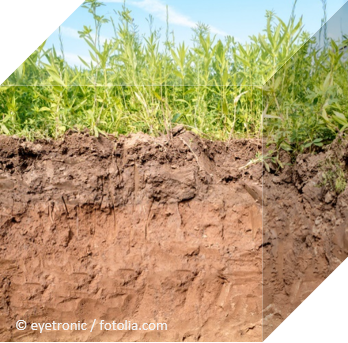 >
Basics >Basic Information > How are innovative materials (e.g.nanomaterials) transported after their release?
>
Basics >Basic Information > How are innovative materials (e.g.nanomaterials) transported after their release?
Innovative materials and Nanomaterial can be released from various sources, entering the environment and thus getting in contact with humans, plants and environmental organisms. It is estimated that less than 0.1 per thousand of the overall air pollution are engineered materials, the majority of particles originate from natural sources such as dust or pollen. In terms of quantity, this corresponds to less than a “pea” in an Olympic size swimming pool.
The estimated amount of engineered nanomaterials released into the environment per year is approximately 300.000 tonnes. Due to the diversity of materials, no information is available for innovative materials in total. The nanomaterials are primarily metals and metal oxides (e.g. titanium dioxide or iron). Once released, nanomaterials can be transported and distributed on different ways in the air, water or soil based on their origins. Depending on the environmental compartment, the dwelling time, mobility, and reactivity of the nanomaterials varies. The nanomaterials can dissolve, be transformed into other compounds, or form larger particles/agglomerates.
Air
 Once released into the air, especially the nano fractions remain in the atmosphere for hours to weeks due to their low weight and will be spread widely by the wind. The released nanoparticles’ behaviour in the air resembles that of natural particles, e.g. pollen or Sahara dust. They can be inhaled by humans and animals from the air and are thus incorporated into the body (see also “How can innovative materials (e.g., nanomaterials) enter the body or the environment?“). The nanoparticles agglomerate with other particles thus forming larger particles. The airborne nanomaterials are removed either via washing out by rain or via deposition on the ground or surfaces of plants, respectively. Following the removal from the air, the majority of the nanomaterials is transported via rivers ultimately ending up in the oceans. Only a smaller proportion remains in the soil.
Once released into the air, especially the nano fractions remain in the atmosphere for hours to weeks due to their low weight and will be spread widely by the wind. The released nanoparticles’ behaviour in the air resembles that of natural particles, e.g. pollen or Sahara dust. They can be inhaled by humans and animals from the air and are thus incorporated into the body (see also “How can innovative materials (e.g., nanomaterials) enter the body or the environment?“). The nanoparticles agglomerate with other particles thus forming larger particles. The airborne nanomaterials are removed either via washing out by rain or via deposition on the ground or surfaces of plants, respectively. Following the removal from the air, the majority of the nanomaterials is transported via rivers ultimately ending up in the oceans. Only a smaller proportion remains in the soil.
Water

In general, released particles (e.g., engineered nanomaterials) are being transported over long distances in inland waters and oceans via the existing water current. Their behaviour in water varies depending on the material and particle size. Nanomaterials can dissolve in the aqueous environment, remain in the water or agglomerate with other particles resulting in the settling of the particle agglomerates at the bottom of the water.
The majority of particles enriched in wastewater is removed from the water during the different processes within a wastewater treatment plant. However, some remaining non-separable nanomaterials can still enter inland waters via the treated wastewater.
Soil
 Most particles such as engineered nanomaterials or fragments from geotextiles (e.g., foil composites agriculture) are less mobile in soil with only little transport of such materials occurring into deeper soil regions. Therefore, insoluble particles or fragments can accumulate in the soil, agglomerate with other substances or dissolve. If degraded or dissolved, the released ions are more mobile and can be washed out with rainwater. This also applies to nanomaterials in the sediment of lakes or rivers, which have a low mobility and remain at the site of deposition.
Most particles such as engineered nanomaterials or fragments from geotextiles (e.g., foil composites agriculture) are less mobile in soil with only little transport of such materials occurring into deeper soil regions. Therefore, insoluble particles or fragments can accumulate in the soil, agglomerate with other substances or dissolve. If degraded or dissolved, the released ions are more mobile and can be washed out with rainwater. This also applies to nanomaterials in the sediment of lakes or rivers, which have a low mobility and remain at the site of deposition.